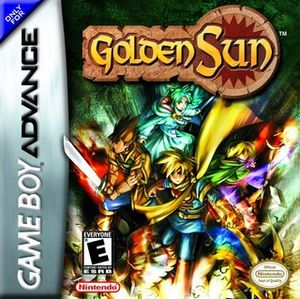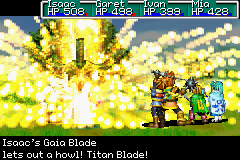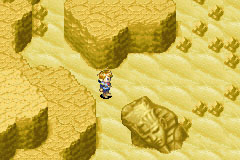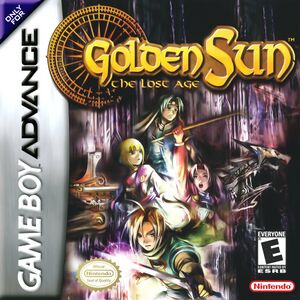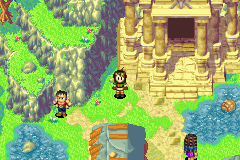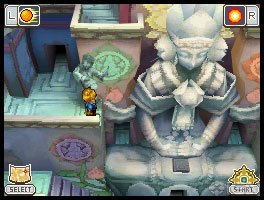Golden Sun series
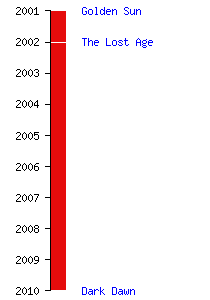
The Golden Sun series is a series of video games created by Camelot Software Planning and published by Nintendo for various portable systems. At present, three games have been released, the most recent being released in North America on November 29th, 2010. There has also been a minor series cameo appearance in another Nintendo game, and a Japanese-only humor volume as well.
For a detailed outline of the plot and progression of events through the main series, see the detailed GBA plot summary and the detailed Dark Dawn plot summary.
For a directory toward all gameplay-related articles, see the game data directory.
For a repository of unsolved mysteries and unanswered questions about the series that nonetheless allow the audience to make educated guesses about them, see the implications collection.
Golden Sun
- Main article: Golden Sun
The first game, sometimes referred to by its Japanese subtitle "The Broken Seal" to differentiate it from The Lost Age, was released in Japan in August 2001, North America in November 2001, and Europe in February 2002. It focuses on the journey of Isaac, Garet, Ivan, and Mia in pursuit of a band of antagonists led by Saturos and Menardi. Saturos' group intends to unleash the sealed power of Alchemy unto the world by using the four Elemental Star jewels to light the energy beacons atop the four Elemental Lighthouses situated across the world; Isaac's party is tasked by the Wise One, the omniscient guardian of the seal placed on Alchemy, to prevent this on the basis that it is a power that would spell potential cataclysm for the world if mankind were to abuse it. The world of Weyard is introduced to the player, but only a limited portion of it is explored; the majority of the plot progression takes places on the continent of Angara and the upper half of the neighboring continent of Gondowan to the south, and two of the four Lighthouses serve as the stages for story and plot revelation.
The various base concepts of the GBA series that are established in Golden Sun include exploring random encounter-filled dungeons that are filled with environmental and layout-based puzzles that obstruct the player's path, and the Psynergy system which is used both to solve such puzzles and to serve as battle commands for various purposes in combat. In addition, the Character Class system, the Summoning system, and the collectible Djinn system that directly allows for and provides power to both of these are introduced. 28 Djinn are available to find and earn, 7 for each element and 7 to be allocated to each of the four playable characters, and the original 16 summon sequences that the party inherently knows are introduced as well.
Upon completing the game, a Completed Data file may be saved on the menu screen, and it is revealed by The Lost Age that this serves as what The Lost Age uses to enhance its own content based on the inventory and game achievements the player committed in this game. Data transfer between Golden Sun and The Lost Age may be achieved by opening up a hidden "Send Data" feature on this game's main menu, selecting the Completed Data file, and either linking up both game carts via two GBA systems and a Game Link cable, or by using a text password this game generates for the player to manually input into a new game file in The Lost Age.
Golden Sun: The Lost Age
- Main article: Golden Sun: The Lost Age
The continuation, released in Japan in June 2002, North America in April 2003, and Europe in September 2003, focuses on members and former captives of the original game's antagonistic party leading their own journey across the world of Weyard: Felix, Jenna, and Sheba are now playable characters, and they soon befriend a new ally named Piers and use his personal sailing ship to explore the oceans of the world and the many islands and continents surrounding the original two continents. Felix leads the group toward their objective to complete Saturos' goal to light the remaining Elemental Lighthouses and release Alchemy to the world, and they are pursued by the heroes of the previous game, who intend to stop them at all costs. Another issue Felix must contend with are the new pair of warriors Karst and Agatio, who are bent on seeking out Isaac to slay him in retaliation for his group's murder of Saturos and Menardi. Nothing can prepare either Felix or Isaac for the shocking revelations to come, which prompts them to join forces late in the game to form a final traveling party of eight.
Many of the concepts brought back from Golden Sun, if not all of them, are expanded upon with new material, and several new features are added as well. The far more massive game world, of which none of the previous game's areas and locations can be explored, is the setting of a much longer and more non-linear quest that requires exploration both by land and by sailing the new ship across the seas. The dungeons themselves are much larger, more mazelike, and are filled with much more challenging puzzles, but also contain much stronger equipment from chests. There are four new playable characters, to which the four previous characters are eventually added to form a final party of 8 Adepts. There are 44 new Djinn, which when added up with the 28 Djinn the previous game's party may bring with them form a grand total of 72 Djinn, 18 for each element and 9 for allocation to each character. This causes class series to become stronger, as well as introduces several entirely new class series, three of which are granted by unique equippable items that may be discovered. There are thirteen new summon sequences that may be discovered throughout the game in the form of hidden, collectible Summon Tablets, which take any number of two separate elements of Djinn On Standby to use and include secondary effects in their attacks. Finally, much of the game's new gear comes about from a new, randomized item crafting system available in one particular town, making use of collectible forgeable materials as well as rusty items that need to be reforged.
The changes to gameplay brought about by transferring data from a completed save file from the previous game include primarily the inventory, statistics, and Djinn collections of the original game's party when they join Felix's party late in The Lost Age. Also, several bonus events may trigger based on what was achieved in the previous adventure, some of which yield unique equipment. The most important effect of this is that all 72 Djinn may be amassed; hidden throughout The Lost Age are four optional "super dungeons" explorable late-game that are more challenging than the mandatory dungeons, and while three of them may be explored in any case, the final and most challenging dungeon in the series, the Anemos Inner Sanctum, may only be entered when all 72 Djinn are present. It contains the most powerful optional boss in the series as well as the final two summon tablets, Charon and Iris.
Golden Sun: Dark Dawn
- Main article: Golden Sun: Dark Dawn
First announced at E3 2009, released in Japan on October 28 2010, and released in North America and other regions from November to December, Golden Sun: Dark Dawn is the first installment of what has been described as the "main story", to which the Game Boy Advance duology are described as the "prologues". Set thirty years after the end of The Lost Age, the game focuses on the offspring of the previous games' heroes, led by Isaac's son, Matthew. His, Karis', and Tyrell's quest starts out as a search for a rare feather from the gigantic Mountain Roc - a quest handed down to them by Isaac as a rite of passage for them to take as Adepts. However, their journey quickly gets sidetracked as they find themselves entangled in a strange scheme authored by the ruler of the enigmatic, military country of Tuaparang, to whom the commanders Blados, Chalis, and a very familiar face are subservient. As they are joined by friends from a variety of cultural backgrounds - Rief, Amiti, Sveta, Eoleo, and Himi - Matthew's company revitalizes Alchemy-based machinery left behind by the ancients of an age long past, returning regions of Angara to the former glory of ancient civilizations previously believed extinct. But years of racial prejudice and military conflict between humanity and a recently-transformed clan of hybrid beastmen soon comes to demonstrate one thing very clearly: not all of the ancient secrets were meant to be brought back into light.
The entire game is presented in fully 3D polygonal graphics, but otherwise, the various gameplay systems of the Game Boy Advance games are more-or-less retained exactly, and most of the game content, from equipment and Psynergy to summons and monsters, is comprised of a selection of the combined content of the GBA games, interspersed with some new content. The explorable world is comprised of most of the continent of Angara (sans the Bilibin and Imil regions) and the upper half of the Great Eastern Sea that surrounds the continent. Unlike The Lost Age, each of the game's additional party members gradually add themselves to your party, all of them bringing their own collection of Djinn, and each of the eight characters' default class series are different from all the rest. Like in The Lost Age, however, there is once again 72 Djinn, 18 for each element and 9 for allocation to each character, but less than half of these are familiar Djinn returning from the GBA games. There is only one new summon, which together with the other 13 summons of The Lost Age are once again summons to collect either by finding their summon tablets or through special events. Some class series are taken out (notably, the class-changing items) and other class series are added in, and various changes to classes' Psynergy collections are made. Perhaps the biggest core change is a redesigned weapon-unleash system, in which all weapons - Long Swords, Axes, Light Blades, Maces, Staffs and Ankhs, and now Bows and Fist Weapons - have multiple unleashes from which a character chooses randomly whenever he unleashes, the available unleashes are unlocked one-after-the-other for that character as the character gains weapon experience, and many of the unleashes hit multiple enemies at a time.
Despite being a DS title, this installment does not feature any sort of backwards compatibility with the GBA titles. Also, the Battle Mode is removed. In its place, once the final boss is defeated, a post-game file may be saved so that the post-game dungeon may be accessed. Another addition is the Encyclopedia, in which 179 pages on plot and character elements may be automatically filled out as in-game dialogue with text highlights scroll by.
Other appearances
Golden Sun-related characters and content have made smaller appearances in other video games and alternative media that are non-canonical.
Golden Sun 4-Koma Gag Battle
- Main Article: 4-Koma Gag Battle
The Golden Sun 4-Koma Gag Battle is a Japanese-only unofficial doujin manga anthology that was published some months after the first game's Japanese release. Primarily, it is a collection of gags about the first game's characters and setting expressed in comic strips by a group of collaborating manga artists. From a Golden Sun perspective, this product is significant for being the only form of non-video game media the Golden Sun series has appeared in as of yet. See here (Alternate Gallery View) for the main page of a project that aims to upload fan-translated scans of all pages in the manga.
Super Smash Bros. Brawl
- Main Article: Super Smash Bros. Brawl
Super Smash Bros. Brawl, a wild crossover Nintendo fighting game released in March 2008, is the first appearance of Golden Sun characters in any video game in the four-plus years since the release of The Lost Age in 2003. Characters from all manner of famous Nintendo franchises are playable combatants, as well as Sonic the Hedgehog and Solid Snake, and many games and franchises not major enough to see their characters playable play lesser roles such as collectible trophies and assist trophies, which help a combatant fight. Isaac makes his first three-dimensional debut as one of these helper characters, appearing randomly in battle when summoned from an Assist Trophy. When summoned, he uses the Move Psynergy on random opponents to push them off the stage. Isaac also appears as a collectible still figure called a Trophy, and music from The Lost Age is featured as one stage's available battle theme.
| Golden Sun games and media | |
|---|---|
| Main Series Games | Golden Sun • Golden Sun: The Lost Age • Golden Sun: Dark Dawn |
| Cameos: | Super Smash Bros. Brawl & Ultimate |
| Other Media: | 4-Koma Gag Battle • Dark Dawn V-Jump manga |
| Other Information: | Game data directory • GBA plot summary • Dark Dawn plot summary • Staff Credits |
